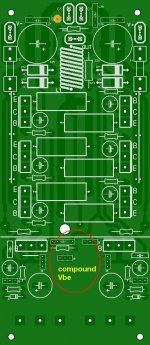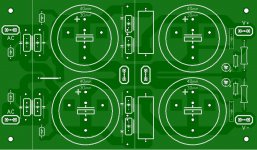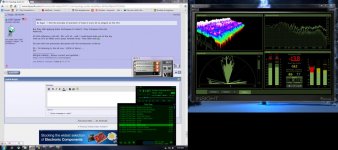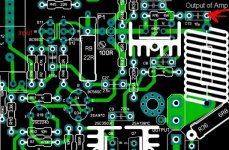Did-you mean filter class AB output to get rid of crossover distortion high order harmonics, then apply the feedback after this filter ?Well, make a class-AB amplifier with 5th order compensation then, or even better, a fifth-order class-A amplifier. It should be easier than a fifth order class D and distort less.
Class D: Some basic info seems to get lost in these comparison arguments.... Driving the Class D development $$ is idle current and small size;
Size and idle dissipation -- idle current draw is lower with class D for small and portable (battery) devices. However, at full power output the 'efficiency' differences are not much better than AB. Fortunately the portable device isn't used much at high output levels.
High Definition audio (low distortion): With Class D--isn't it a fact that as the output goes down the distortion typically goes Up. This is the opposite of analog - esp class A -- where the level goes down the distortion also does down. And since the music details and average listening levels are <1-10W area, that distortion is higher with Class D or similar digital amps, inherently. The data curves on their Class D distortion show the distortion rising from 100W to 10W (.005%). Interesting that they stop at 10W output level because below that is critical to the listening experience. We would need to evaluate the digital signals out of the amp at low power levels and see how linear it is to better correlate measurements to analog or to listening.
Thx-RNMarsh
Size and idle dissipation -- idle current draw is lower with class D for small and portable (battery) devices. However, at full power output the 'efficiency' differences are not much better than AB. Fortunately the portable device isn't used much at high output levels.
High Definition audio (low distortion): With Class D--isn't it a fact that as the output goes down the distortion typically goes Up. This is the opposite of analog - esp class A -- where the level goes down the distortion also does down. And since the music details and average listening levels are <1-10W area, that distortion is higher with Class D or similar digital amps, inherently. The data curves on their Class D distortion show the distortion rising from 100W to 10W (.005%). Interesting that they stop at 10W output level because below that is critical to the listening experience. We would need to evaluate the digital signals out of the amp at low power levels and see how linear it is to better correlate measurements to analog or to listening.
Thx-RNMarsh
Last edited:
Richard and other's,
Have any of you listened to a TI TPA3100D2 or the newer TPA3116/18 parts? Forget about all the spec's, measurements, etc, just take the time to listen to the parts and report your finding in the appropriate Class "D" threads on this forum and then be the judge for yourselves with all the hype and biases put aside.
I myself was skeptical but they really perform quite well regardless of the spec's that do look rather poor. I have been using a self designed TPA3100D2 amp for now 2 years or more and it sounds just fine.
To me it just re-enforces that source/speakers are the #1's as far as SQ goes, by a long shot. Your or at least my ear/brain is not a FFT analyzer and I do not expect it to be one as it is its own, not my design 🙂 processor. God forbid I had any involvement or it would the end of humanity 🙂
The computer screen fatigues me way more than the sound from a Class "D" amp does.
Note: please compare amps of comparable wattage or it can be meaningless comparison, if you like to blast out the tunes.
Happy new year everyone
Have any of you listened to a TI TPA3100D2 or the newer TPA3116/18 parts? Forget about all the spec's, measurements, etc, just take the time to listen to the parts and report your finding in the appropriate Class "D" threads on this forum and then be the judge for yourselves with all the hype and biases put aside.
I myself was skeptical but they really perform quite well regardless of the spec's that do look rather poor. I have been using a self designed TPA3100D2 amp for now 2 years or more and it sounds just fine.
To me it just re-enforces that source/speakers are the #1's as far as SQ goes, by a long shot. Your or at least my ear/brain is not a FFT analyzer and I do not expect it to be one as it is its own, not my design 🙂 processor. God forbid I had any involvement or it would the end of humanity 🙂
The computer screen fatigues me way more than the sound from a Class "D" amp does.
Note: please compare amps of comparable wattage or it can be meaningless comparison, if you like to blast out the tunes.
Happy new year everyone
Last edited:
I confirm. I have a ClassD amp to drive my basses speakers. Comparing the the VFA version of my amp, it was a little better, and have a signature closer to the CFA actual version.be the judge for yourselves with all the hype and biases put aside.
On his side, i remember Lazy Cat had build a Ncore and said, comparing to one of his SSA something like: "same kind of signature, each slightly better on certain aspect than the other".
Easy to listen too, not fatiguing, good separation and space between instruments. Powerful. Analytical.
And one other of my friend, a very 'audiophile' but clever guy had chosen a class D amp for his master own system in between a huge samples of amps.
This said, i have heard prestigious name's D amplifiers not so good as expected, so, it is not good to generalize.
Last edited:
On his side, i remember Lazy Cat had build a Ncore and said, comparing to one of his SSA something like: "same kind of signature, each slightly better on certain aspect than the other".
Yes but VSSA used linear PSU at that time. Using SMPS on class-AB CFA amp PWM doesn't stand a chance. Hybrid amps like Devialet use PWM just as +0 dB output impedance buffer. Heard D-Premier several times, everything was there only the music was lost in translation.
Richard and other's,
Have any of you listened to a TI TPA3100D2 or the newer TPA3116/18 parts? Forget about all the spec's, measurements, etc, just take the time to listen to the parts and report your finding in the appropriate Class "D" threads on this forum and then be the judge for yourselves with all the hype and biases put aside.
I myself was skeptical but they really perform quite well regardless of the spec's that do look rather poor. I have been using a self designed TPA3100D2 amp for now 2 years or more and it sounds just fine.
To me it just re-enforces that source/speakers are the #1's as far as SQ goes, by a long shot. Your or at least my ear/brain is not a FFT analyzer and I do not expect it to be one as it is its own, not my design 🙂 processor. God forbid I had any involvement or it would the end of humanity 🙂
The computer screen fatigues me way more than the sound from a Class "D" amp does.
Note: please compare amps of comparable wattage or it can be meaningless comparison, if you like to blast out the tunes.
Happy new year everyone
I have played with tpa3106 and tpa3110 as well.
The are good and cheap no doubt about it, but there is a limit how high they reach. Also the inductors needed In the output needs to be HQ. Most inductors inductivity is very unlinear and depending on the current flowing through them.
HQ inductors from for example Wurth cost the same as the chip and you need four of them.
But they have their place. We have constructed a Bluetooth speaker using them and bluegiga Technology combined with good fullrange speakers from Dayton audio.
This solution outperform most Bluetooth speakers available.
As CFAs, the result highly depend on PSU quality, yes.Yes but VSSA used linear PSU at that time.
(It was not VSSA, yet, if i remember well)
Last edited:
If done right, like Ostripper it should be a problem as long as the psu is welldimensionet and we dont run at the limit.As CFAs, the result highly depend on PSU quality, yes.
(It was not VSSA, yet, if i remember well)
As a side comment the Bluetooth speaker system used 20mA rms at normal listening level . At max level it uses only 80mA average at 12vdc. This is hare to beat.
Cheap class D amps can do the job - the "silly" Aldi TV combo I played with to do audio playback does perform adequately; like most cheap gear it needs substantial warmup times, and being driven hard to 'lubricate' everything properly. Miniscule power supplies and low cost everything means that the limits are hit on various material fairly early, but apart from that the sound is all of one piece, no complaints ...
Did-you mean filter class AB output to get rid of crossover distortion high order harmonics, then apply the feedback after this filter ?
No, I simply mean having five dominant poles and four compensation zeroes in the feedback loop, such that the loop gain drops at 100 dB/decade between the signal frequency band and an octave or two below the unity loop gain frequency, then bends and crosses the 0 dB loop gain line at a first-order slope. That (combined with a bit of dithering) is how you get decent audio performance out of grossly nonlinear circuits such as the one bit quantisers in single-bit sigma-delta modulators, or the grossly nonlinear output stage of a class-D amplifier. If you apply the same level of negative feedback around a class-A or class-AB amplifier output stage that is already fairly linear by itself, distortion should be immeasurable. You will have to look carefully at the large-signal stability and maybe add a couple of clippers to make it recover properly from overload (or the wrong start-up state), but that can be done; the same has been done for decades in high-order sigma-delta modulators.
Most class-A and class-AB amplifier designers still believe in the need for so-called unconditional stability and don't dare to go higher than first or second order. That's why class D designers can beat them distortion-wise. I've lost my faith in unconditional stability years ago; I've seen too many circuits with first-order compensation burst into uncontrolled large-signal oscillations and too many circuits with third or higher order compensation that work fine.
Member
Joined 2009
Paid Member
The way I see it, there was just such a discussion amongst tube fans about solid state when it came into being. People probably said it was good for high power but would never be as good as tubes for hi-fi. They probably said that solid state Class AB was all about making cheaper more efficient power amplifiers. The move to Class D is following the same tune. It will continue to evolve and it will become every bit as good as we need for hi-fi. In it's basic form I find the principle of operation of Class D every bit as elegant as the CFA. Sorry for OT!!
Last edited:
No, I simply mean having five dominant poles and four compensation zeroes in the feedback loop, such that the loop gain drops at 100 dB/decade between the signal frequency band and an octave or two below the unity loop gain frequency, then bends and crosses the 0 dB loop gain line at a first-order slope. That (combined with a bit of dithering) is how you get decent audio performance out of grossly nonlinear circuits such as the one bit quantisers in single-bit sigma-delta modulators, or the grossly nonlinear output stage of a class-D amplifier. If you apply the same level of negative feedback around a class-A or class-AB amplifier output stage that is already fairly linear by itself, distortion should be immeasurable. You will have to look carefully at the large-signal stability and maybe add a couple of clippers to make it recover properly from overload (or the wrong start-up state), but that can be done; the same has been done for decades in high-order sigma-delta modulators.
Most class-A and class-AB amplifier designers still believe in the need for so-called unconditional stability and don't dare to go higher than first or second order. That's why class D designers can beat them distortion-wise. I've lost my faith in unconditional stability years ago; I've seen too many circuits with first-order compensation burst into uncontrolled large-signal oscillations and too many circuits with third or higher order compensation that work fine.
You raise a lot of very interesting issues. High-order compensation/feedback schemes can be used for conventional class AB amplifiers, but I believe that the results achieved in this and many other DIYaudio threads (and commercial amplifiers) demonstrate that such high-order feedback approaches are unnecessary for class AB amplifiers. So why invite conditional stability in them?
Perhaps the answer is to make cheaper class AB amplifiers and improve them with high-order loops? Not sure.
At the same time, class D probably does need higher order loops in its various incarnations (conventional PWM, self-oscillating PWM, Sigma-Delta PDM, etc.). However, the use of such high-order loops in some of these approaches, especially those using DSP, may have fewer concerns with conditional stability.
The focus needs to be on making class D as good as the best class AB designs, while retaining the best features of the class D technology. Let us not forget that new technologies may introduce new artifacts that we are not accustomed to measuring and evaluating with conventional measurements. For example, EVERY class D amplifier involves some form of quantization and sampling, and the effects of these on SQ are not always immediately fully understood.
Cheers,
Bob
For example, EVERY class D amplifier involves some form of quantization and sampling, and the effects of these on SQ are not always immediately fully understood.
+1 - it is well established that the probability density function of the dither applied at quantization is important and I've yet to see a treatment where the dither (which needs to be applied within a feedback loop) can be controlled so as to achieve TPDF. Noise modulation is the result if not and plenty of signa-delta DAC designs (even the much lauded ESS chips) show this when stimulated with appropriate signals.
Thanks for comment .. and happy new year !If done right, like Ostripper it should be a problem as long as the psu is welldimensionet and we dont run at the limit.
As a side comment the Bluetooth speaker system used 20mA rms at normal listening level . At max level it uses only 80mA average at 12vdc. This is hare to beat.


Being uninhibited (3 1/2 hours now) , and listening to Boston "don't look back"
on the Sansui.
To comment - I never meant to denigrate class D , but AB is not "left in the dust".
The "alien" CFA might just breath new life into it.
Being a blameless man , I never really liked symmetric topologies - they sound
"hard" ... best for nightclubs and parties.
Just by simulating and interpreting the residuals of my CFA , this might be different ...
along with that mad slewrate - I'm nearly sure it will SOUND
different.
While the discussion is interesting , I must KNOW-for real ... (below) , I give
"tender loving care" to my capacitance multipliers and split star grounds.
My "baby" will sing
 with the HK triple and any number of IPS's.
with the HK triple and any number of IPS's.PS - fully modular (square pads at bottom) - with aesthetics and good engineering. 😀
As far as power supplies - I have that covered , too (below 2).
The layout of the CFA IPS will be "art" (more to consider/FB wise). Toner ordered !!
ahhh .. I feel like a "tube man" in a class D world ..
OS
Attachments
By bigun - I find the principle of operation of Class D every bit as elegant as the CFA
But they ARE applying linear techniques to class D. They transpose this into
PWM info.
45-50% efficiency with AB , 85+ w/D oh , well. I could knock bats out of the sky
with my CFA at 40Khz and a piezo tweeter array. They filter that 😀
I'm sure this was previously discussed with the introduction of silicon.
PS - I'm listening to the HK now ! 200W of silicon ... oh .. and happy new year
OS
Attachments
Last edited:
Member
Joined 2009
Paid Member
And Happy New Year to you too 😀
I think you'll end up liking the symmetrical topology just fine, it's rarely truly symmetrical anyhow. I've built two symmetric amps, the one that surprised me wasn't my version of the VSSA though, it was Greg Ball's SKA - my first MOSFET amp and I was pleasantly surprised. Since them I'm quite open to symmetric designs.
I think you'll end up liking the symmetrical topology just fine, it's rarely truly symmetrical anyhow. I've built two symmetric amps, the one that surprised me wasn't my version of the VSSA though, it was Greg Ball's SKA - my first MOSFET amp and I was pleasantly surprised. Since them I'm quite open to symmetric designs.
Last edited:
We are in the same time zone .. ahh.And Happy New Year to you too 😀
I think you'll end up liking the symmetrical topology just fine, it's rarely truly symmetrical anyhow. I've built two symmetric amps, the one that surprised me wasn't my version of the VSSA though, it was Greg Ball's SKA - my first MOSFET amp and I was pleasantly surprised. Since them I'm quite open to symmetric designs.
Your horrible canadian air is here 😀 , awful 3 degree (F) -with wind.
I will take the time , make the NX/hawksford into my "baby" .. it
will rock (smoke the blameless) ...you know what I mean. 😀
OS
+1 - it is well established that the probability density function of the dither applied at quantization is important and I've yet to see a treatment where the dither (which needs to be applied within a feedback loop) can be controlled so as to achieve TPDF. Noise modulation is the result if not and plenty of signa-delta DAC designs (even the much lauded ESS chips) show this when stimulated with appropriate signals.
Hi Abraxalito,
Happy new year!
Good point. Anything based on sigma-delta modulation with two or three level quantisation cannot be dithered properly, because 2 LSB peak-to-peak triangular probability density function dither would already overload the quantiser. That's also why Lipshitz and Vanderkooy dislike the direct stream digital format (Sony brand name for a single-bit sigma-delta modulate) used on SACD.
In practice, dithering of single-bit sigma-deltas is usually done quite pragmatically: just add a bit of noise at the quantiser input and increase its level until you don't see the distortion peaks anymore. The probability density function of the dither typically consists of two Dirac impulses with an area of 1/2, because it is typically just a single-bit pseudo-random bitstream.
Best regards,
Marcel
Last edited:
- Home
- Amplifiers
- Solid State
- CFA Topology Audio Amplifiers



